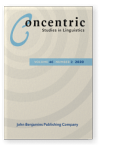Vol. 46:2 (2020) ► pp.148–172
The role of duration in speech plans uncovered by startling auditory stimulus
This study investigated how speech targets of different durations may be specified in speech plans and the release in response to startling auditory stimulus (SAS) triggering. In particular, we examined whether differentiated musical training background affects responses in terms of the preservation of duration. The results show that facilitated reaction time (RT) is only observed in SAS-induced responses shorter than 500 ms, suggesting that targets longer than 500 ms may not be as susceptible to SAS-induced rapid release. While both musically trained and untrained participants lacked accuracy in producing targets with fixed durations, they were able to differentiate syllable lengths, even though duration does not denote phonemic contrasts in Mandarin. The results also show a degree of compensation to elevated pitch level from musically trained participants, suggesting that they may have a higher sensitivity to pitch level even within a limited duration window.
Article outline
- 1.Introduction
- 2.Experiment I
- 2.1Methods
- 2.1.1Participants
- 2.1.2Apparatus, task, and procedures
- 2.1.3Data preparation, reduction and analyses
- 2.1Methods
- 3.Results
- 3.1Startle rate and EMG burst onset
- 3.2Acoustic responses
- 3.2.1Acoustic RT
- 3.2.2Duration
- 3.2.3Pitch
- 3.2.4Formants
- 4.Experiment II
- 4.1Methods
- 4.1.1Participants
- 4.1.2Apparatus, task, recording equipment and procedures
- 4.1.3Data preparation, reduction and analyses
- 4.1Methods
- 5.Results
- 5.1EMG burst onset
- 5.2Acoustic responses
- 5.2.1Acoustic RT
- 5.2.2Duration
- 5.2.3Pitch
- 5.2.4Formants
- 6.General discussion
- Acknowledgements
-
References
